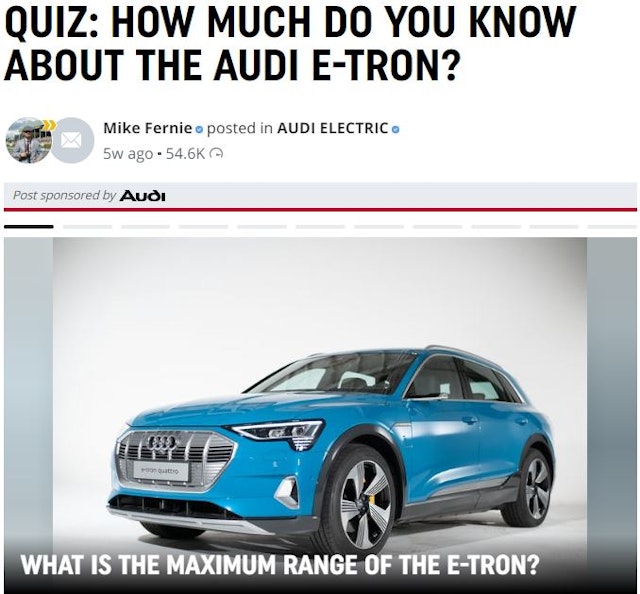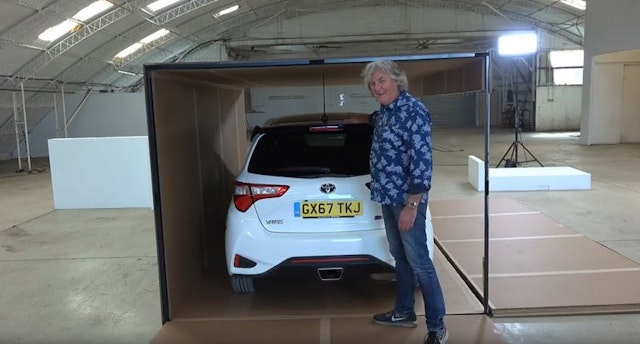DriveTribe's profit pursuit required solving social and digital media's biggest problems
DriveTribe, the car-community media brand founded by The Grand Tour trio Jeremy Clarkson, Richard Hammond and James May in 2016, is gaining momentum by developing a unique business model that informs the marketing campaigns of the world’s biggest auto brands.
The media brand's website looks like a cross between an auto publication, Facebook and Reddit. It has arranged its content around ‘Tribes’ like Motorsports, Rally, Celebrity and more, all administered by a team of around 50 staff members and countless regular contributors. To get to this scale, it has had to solve the monetisation issues plaguing digital media and the algorithmic hiccups hampering social media companies like Facebook – and in doing both it has developed an engagement-centric model that it is now pitching to brands.
DriveTribe's chief executive, Jonathan Morris and contributor James May, spoke to The Drum about how the brand is now serving as a ‘petri dish’ for marketers. Morris believes the Tribe approach may serve as a guiding light to niche publishers intent on delivering maximum value to vital brand partners.
In its first year, DriveTribe breached one million users. With the scale in the bag, the next step was to attract brand partners to pursue profitability and sure enough in year two it signed its first major advertiser in Audi. Its Audi e-vehicle content, it found, generated valuable feedback from users and since then, it has been able to levy the power of its highly-engaged enthusiast audience as market research. Auto partners, including Renault, have come aboard for this mix of marketing and fact-finding.
It may come as a surprise, Morris admits, that DriveTribe did not have a solid business model until he took over in November 2017.
Unique partnerships
He says: “Year one was about growing the audience and the brand – and we learned we should steer clear of the social media advertising arbitrage model where you buy £100 of ads on Facebook to make £105 pounds in impression-based advertising.”
Pumping up the scale of the mag to monetise a niche site is a “mug’s game” in his opinion. “Unless you are already very big then the best you can do is lose less money than your competitors.”
Instead, DriveTribe realised that its users generate millions of data points (around 15m at the moment). This can inform brands about auto trends and user opinion.

When courting advertisers, DriveTribe downplays promises of vast social reach buyers may have come to expect. It has learned that several clients also had doubts about the effectiveness of mass reach against a highly engaged audience, and that the auto industry is in need of guidance from consumers. It is currently being disrupted by tech like self-driving cars, sustainable fuel, new car financing, Uber and environmental and health awareness.
These industry shifts mean that “the big brands have to change how they market and how they talk to users,” Morris says. "They need communities they can talk to." DriveTribe has positioned itself to deliver this.
The discovery of this model was in someways a fortuitous accident. Morris realised that Drivetribe was already a brand-friendly place where users discussed the pros and cons of certain car brands. It trialled content marketing, surveys and more to help Audi (better) promote the Audi e-tron electric car.

“We discovered that Audi’s e-tron marketing wasn't quite hitting the right notes. They believed consumers were most concerned about range anxiety and speed but our data found the opposite. Range concerns were overblown, many were planning to buy for the school run and train stations runs as most of them don't actually drive long distances. Also marketing it as a performance car was wrong [because] people were worried they could accelerate too quickly and would put it in the wrong gear and blast through the back of the garage.”
The Tribes were most curious about the e-tron's interior design, its accessories and the noise of its engine. The media brand claims its feedback and data capture is more credible than the industry-standard weighted consumer research and the next stage is to build e-commerce and competition incentives into the product.
Morris says: “Investors see us as a petri dish for a future business model that is not reliant on monthly active users but daily active users and the number of data points they are putting into the core system. Our model is more like a mobile game than an impressions-based publisher”.
As a result, DriveTribe boasts users, not readers, and it needs them to engage as often as possible. To do this, it is looking to inspire a higher quality of content from its top contributors with an ad-revenue share system called Money Box which can be applied for by top creators.
The algorithm issues
In-house journalism and user-generated content were once exclusively ranked and placed by DriveTribe’s all-seeing algorithm; this opened the site to abuse and the algorithm lacked the nuance to spot an informative video or compelling opinion piece.
Morris admits that early criticism was not entirely unfounded. “In the early days a funny, spammy post could perform well because the algorithm loved it. We learned that you need to have real human beings checking that the algorithm hasn't gone mad.”
A team of around 150 ambassadors were put in place to run the Tribes and elevate the best content to make the site a fairer place and live up to DriveTribe's demographic promise.
“Someone who posts one piece of great content a month has a fair crack of the whip now, at the start you could bang out a post every ten minutes and the algorithm would love you – to the detriment of the users.”
He adds: “We were naive and soon realised that we were going to suffer from all of the problems of the big social networks. But, because we are around the car vertical (rather than everything from cat videos to family pictures) we were able to solve that much easier than Facebook, Instagram or Snapchat.”
Furthermore, to improve the health of the site, it culled thousands of “zombie Tribes” to focus on the ones that were flourishing.
The launch of this new platform was timed to coincide with the release of Amazon’s first season of The Grand Tour to best benefit from a publicity lift generated by the fame (or infamy) of Clarkson, Hammond and May. Morris admits: “We took a bit of heat about the fact it wasn't perfect on day one. It was nigh on impossible to immediately get it right.”
With series investment into a bulky digital team, DriveTribe owns a platform it now must attract users to. This high-risk, high-reward approach at least insulates the media company from the wider movements in the world of social and search. To social media-dependent publishers, Morris warns: “It could all go away tomorrow with the strike of a pen from Mark Zuckerberg, he has the total right to do that. It concerns me that so many startups rely on social networks. It is a mistake to assume these guys are on your side."
To him, it is “the guys with owned and operated platforms that will win in the end”.
The Grand Tour trio
DriveTribe would not be here today without the marketing lift granted by Clarkson, Hammond and May. Morris says they bring social influence, deliver content, status, guide the product, engage the community and work with commercial partners – the trio are in some cases are bigger brands than most car manufacturers.
“This isn't a startup where the celebrities are never seen or heard from, they are very involved and will be at the staff Christmas party. They are a strong guiding light.
"It was one of the reasons we went to market so quickly. You usually do a soft launch and get it right but we had to immediately jump off the cliff. I would have fewer grey hairs if we had [soft launched] but now we are quite well known."

TV personality and The Grand Tour host James May shared with The Drum he weighs his responsibilities between the brands.
"Amazon has come to see the value of it. They think it is pretty cool. [The Grand Tour and DriveTribe] are perfectly complementary, some people say ‘that is TV, you shouldn't put it on the internet’ but our TV show is actually on the internet so they are not very far apart really.”
He then led into his experience of working on DriveTribe. He writes long-form reviews, runs selfie-like updates and even leans into his inner influencer by partaking in unboxing videos. Captain Slow is speeding into the future of media – perhaps.
He says: “In some ways, this is what we always wanted to do. I was never a news journalist, when I wrote for The Telegraph and car magazines, I wrote columns and reviews and travel stories. I remember there was a moment in the history of The Daily Telegraph that they put it online and there would be discussions on my columns between a fairly hardcore, regular number of people that we could debate and I always enjoyed that. DriveTribe is a very sophisticated and inclusive version of that on a bespoke platform that allows for videos and nice pictures and is very easy to use."
May suggests some hacks may fear this discourse with their readers. “They are worried that it will find them out. Paper was the best that we had, the ideas are not different they are just more accessible, and more people can join in.”
For him, DriveTribe encapsulates many of the best aspects of social media, and sidesteps some of the worst.
“DriveTribe is devoted to one subject in its very broadest form, it is not a hardcore car-nerd website but it is not Twitter either. You get car stuff on Twitter and Facebook but DriveTribe is a community, there is always that common ground. You are dealing with people that are at least intrigued by the subject in some way so the responses tend not to be nasty, but constructive or critical and therefore generally quite stimulating.”
In particular, some of the discussion he has generated around certain topics has given him the belief that there is something that clicks with this community-based approach to media.
“it is not about getting millions and millions of people to click your post or hit the Like button, the measure of your success is how many people want to join in the discussion.
“I thought that about TV as well, it is important that the people watching get something out of it. We all secretly want millions of people to watch our shows because we all have fragile egos and we are inadequate and that is why we are on TV but ultimately it feels better to go niche and get a really positive or impassioned response than to do something big and bland that maybe gets a lot of viewers but doesn't leave you any wiser.”
May concludes: “You could do these verticals over anything, people associate us with cars so we did it about cars. When you are known pretty much globally for arseing around with cars, it will help a lot more than just being a startup.”
Chief strategy officer of DriveTribe Richard Beech offered a hint of where the company is going.
“After a good year of commercialisation, we have a model we can scale up and move to other verticals. The next level of funding will help the title scale up and slip into new verticals under the same model.”

